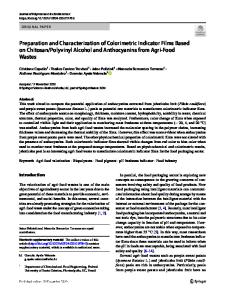Preparation and Characterization of Gamma Radiation Assisted Poly-Vinyl Alcohol/Acrylic Acid/Poly-4-Styrene Sulphonic Ac
- PDF / 5,389,621 Bytes
- 18 Pages / 595.276 x 790.866 pts Page_size
- 58 Downloads / 301 Views
ORIGINAL PAPER
Preparation and Characterization of Gamma Radiation Assisted Poly‑Vinyl Alcohol/Acrylic Acid/Poly‑4‑Styrene Sulphonic Acid Based Hydrogel: Application for Textile Dye Removal Md. Arif Roman Azady1 · Md. Saiful Alam1 · Shujit Chandra Paul1 · Md. Saifur Rahaman2 · Salma Sultana2 · Shah Md. Marzuk Hasnine2 · Tanvir Ahmed2 · M. A. Gafur3 Accepted: 18 September 2020 © Springer Science+Business Media, LLC, part of Springer Nature 2020
Abstract In this study, poly-vinyl alcohol (PVA), acrylic acid (AAc), and poly-4-styrene sulphonic acid (PSSa) were copolymerized in different compositions using gamma irradiation to form the hydrogel. FTIR study showed that AAc act as a crosslinker for the formation of transparent hydrogel and optimization study affirmed that crosslinking density increased with the increase of AAc content. The swelling study revealed that hydrogel with 30% acrylic acid and 70% PSSa ( PAC30PS70) exhibited the best swelling properties with a maximum diffusion coefficient of 2.94 cm2s−1 and the diffusion of water inside the hydrogel was found to be of Fickian character. Methylene blue was used as a model dye for sorption and the effect of sorbent dosage, contact time, initial dye concentration, pH, and temperature on sorption were observed for the study. The maximum sorption capacity of 131.58 mg/g was observed at normal temperature, neutral pH, and hydrogel dosage of 0.05 grams (g). The sorption of dye data best fitted with pseudo first-order kinetic equation and Boyd kinetic plot indicates that the adsorption process was controlled by film diffusion (external diffusion). The negative values of ΔH (− 18.57 k jmol−1) from the thermodynamics study, confirmed that the adsorption process was exothermic and more favorable at lower temperature. The reusability study specified that the sorption capacity gets reduced from 90.96 to 57.45% after four consecutive cycles ensuring that the hydrogel can be effectively utilized as recyclable adsorbents for industrial applications. Keywords Hydrogel · Poly-vinyl alcohol · Acrylic acid · Gamma radiation · Methylene blue · Thermodynamics · Reusability
Introduction Electronic supplementary material The online version of this article (https://doi.org/10.1007/s10924-020-01897-3) contains supplementary material, which is available to authorized users. * Shujit Chandra Paul [email protected] * Md. Saifur Rahaman [email protected]; [email protected] 1
Department of Applied Chemistry and Chemical Engineering, Noakhali Science and Technology University, Sonapur, Noakhali 3814, Bangladesh
2
Institute of Nuclear Science and Technology, Atomic Energy Research Establishment, Bangladesh Atomic Energy Commission, Savar, Dhaka 1349, Bangladesh
3
Pilot Plant and Process Development Centre, Bangladesh Council of Scientific and Industrial Research, Dr. Qudrat‑E‑Khuda Road, Dhaka 1205, Bangladesh
Although water is an important element of our environment, it is getting polluted day by day from various kinds of waste, organic and inorg
Data Loading...











